“Authentic, organic, and honest”: 16 examples of how user-generated content helps brands retain loyal customers—and acquire new ones

In January 2019, when the company was much smaller, italist received “one of the best unprompted endorsements” from an influencer on Instagram, recalls CEO Diego Abba.
Dorothy Wang, daughter of billionaire Roger Wang and star of reality show Rich Kids of Beverly Hills, shared this photo with her 1M followers, crediting italist with helping her find the Louboutin So Kate pumps that completed her birthday outfit:

Image source: Dorothy Wang’s Instagram
“Those who follow my stories might remember that I couldn’t find these Louboutin So Kates in my size to complete my birthday ensemble anywhere,” Wang wrote in her caption. “I am so happy my savvy friend KC Sukamto told me about italist and I want to share it with anyone searching for a hard-to-find item!”
“My shoes also ended up being a little less than what I would normally pay (yay for Italian pricing) and the automatic express two-day shipping got them to me in time for the festivities,” she added. “Happy birthday to me!”
The thank-you note was spontaneous and completely organic, Abba says: Wang had no prior engagement with italist, but “she highlighted very well the two key advantages of our site: the vast selection from 1.5K luxury brands, and the lower pricing.”
Wang’s post received nearly 36K likes—and it’s a perfect example of the power of user-generated content (UGC).
More than any other kind of marketing, UGC allows you to talk with your customers, rather than at them. It’s “a key part of the two-way communication that we have with our consumers, thanks to technology and social media,” Abba explains.
UGC is a key part of the two-way communication that we have with our consumers, thanks to technology and social media.
That makes UGC a perfect fit for a brand like italist, whose online store gives shoppers access to when-in-Rome pricing (up to 40% lower than the rest of the world) and 250K+ SKUs from independent Italian boutiques—from anywhere with an internet connection.
“Not many brands or retailers in the luxury space actively use UGC, in part because the luxury business is built on exclusivity, not inclusion,” Abba points out. “We see our work as democratizing luxury in a small way—making pricey things a bit less pricey, and providing another option for shoppers beyond traditional department stores or having to buy directly from a brand.”
In the same way that italist is democratizing luxury fashion, then, UGC democratizes content production by flattening traditional top-down media and advertising hierarchies. “UGC makes sense to recognize and reward new customers, loyal customers, and build a strong community around our business,” Abba explains.
UGC makes sense to recognize and reward new customers, loyal customers, and build a strong community around our business.
Not all UGC comes from influencers with large social followings. But all of it can be instrumental in turning one-time shoppers into lifelong brand advocates. Read on to learn how.
What is UGC?
UGC is original content customers share that brands can use in their marketing efforts. Essentially, it’s today’s version of word-of-mouth marketing: anything people are saying or showing about your brand, online, to their own followers and networks.
Typically, UGC showcases how real people are using your product in their daily lives. Some UGC, however, might fall more into the realm of lifestyle content—stuff that showcases how your customers’ values align with your brand’s ethos.
Since italist, for example, sells 1.5K brands but not products under their own name, UGC that falls into the latter category is particularly valuable—“stories about italist as a useful service and a seamless experience,” Abba says, “rather than simply posts which include an item purchased from italist.”
With UGC, your audience takes an active, participatory role in your marketing.
Most UGC is organic, like Wang’s italist shout-out above. But brands can also pay creators to make it. Both types of UGC have their benefits—the former is more raw and unadulterated, while the latter gives the brand more control over content scripts and visuals.
But either way, with UGC, your audience takes an active, participatory role in your marketing.
Here’s an even easier way to think about it: If the content is associated with your brand but wasn’t officially created by your brand, it’s probably UGC.
The 4 main types of UGC
UGC comes in many forms. “It’s more than just text,” explains Shaun Lin, director of channel partnerships at Bazaarvoice, a people-first UGC software platform that enables 12K+ brands and retailers to collect and display several types of UGC on their websites and digital touchpoints. “It’s images, it’s video—it’s everything.”
“There’s no one size fits all,” agrees Ben Schreiber, head of ecommerce at Latico Leathers and co-founder of Forbes-rated boutique ecommerce agency Brand Caffeine, which specializes in paid ads, email marketing, and UGC content creation. “It’s really different for every product and every brand.”
The 4 main types of UGC include:
1. Visual UGC
Visual UGC refers to photos and videos shared by customers who are interacting with your brand or products.
And it’s crucial. UGC in the form of shopper photos increases the likelihood of a purchase for 74% of consumers—and 42% of shoppers will still buy a product if there are no professional product photos, according to the 2022 Bazaarvoice Shopper Experience Index.
People want to see real-life photos in addition to the branded photos that companies put on product description pages.
“People want to see real-life photos in addition to the branded photos that companies put on product description pages, and they want to see videos of the product experience—a real person talking about that experience in a real environment, as opposed to a studio-produced video,” Lin explains.
Take a look at how dog apparel brand Wild One uses visual UGC to their advantage on their Instagram account—their posts are a mixture of branded photography and UGC:
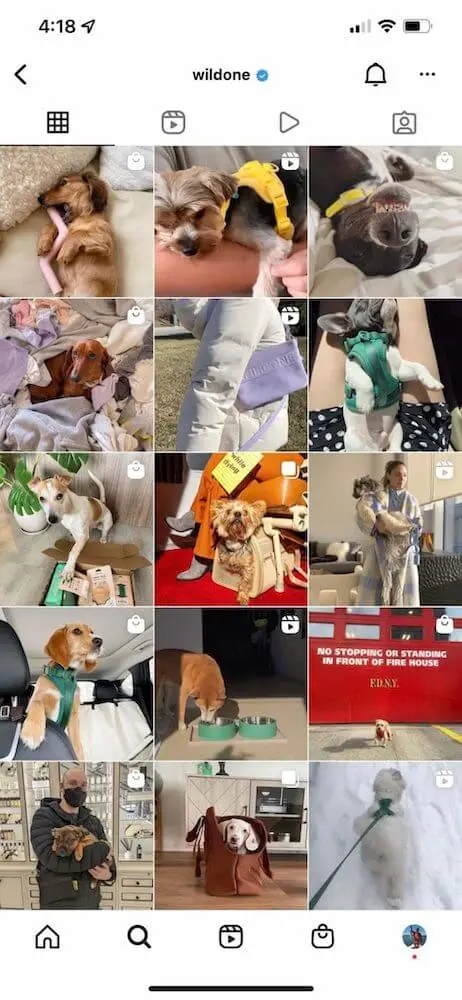
Image source: Wild One’s Instagram
Visuals, here, go much further than words would. By displaying a wide variety of dog breeds in various iterations of their products on their feed, Wild One allows potential customers to scroll through for a quick sense of how a Wild One collar might look on their dog, or whether their toys are the right size for their pet.
2. Social media posts
Social UGC refers to tweets, Instagram stories and posts, TikTok videos, and Facebook posts that involve your brand. And this kind of content, which can come in the form of copy or visuals, is important for more than just brand awareness.
According to the Bazaarvoice Shopper Experience Index, social media content has inspired 69% of consumers to make a purchase—and over half have actually shopped through social commerce.
It’s no secret that consumers of all ages spend hours on social media every day. In the last year alone, Bazaarvoice reports that time on social has increased significantly for 80% of shoppers.
And for much of that time, they’re interacting with content posted by regular people, not celebrities or brands. According to Statista, the most common social media activities in 2022 included:
- Liking posts by other users: 53%
- Sending private messages: 49%
- Commenting on posts: 48%
- Posting photos/videos: 41%
- Sharing posts by other users: 35%
By contrast, people spend far less time engaging with companies on social, Statista reports:
- Liking company posts: 25%
- Following companies: 20%
- Sharing company posts: 15%
Because it was 100% organic, Wang’s italist shout-out would qualify as social (and visual) UGC, as would this post from an everyday Instagram user and italist customer:
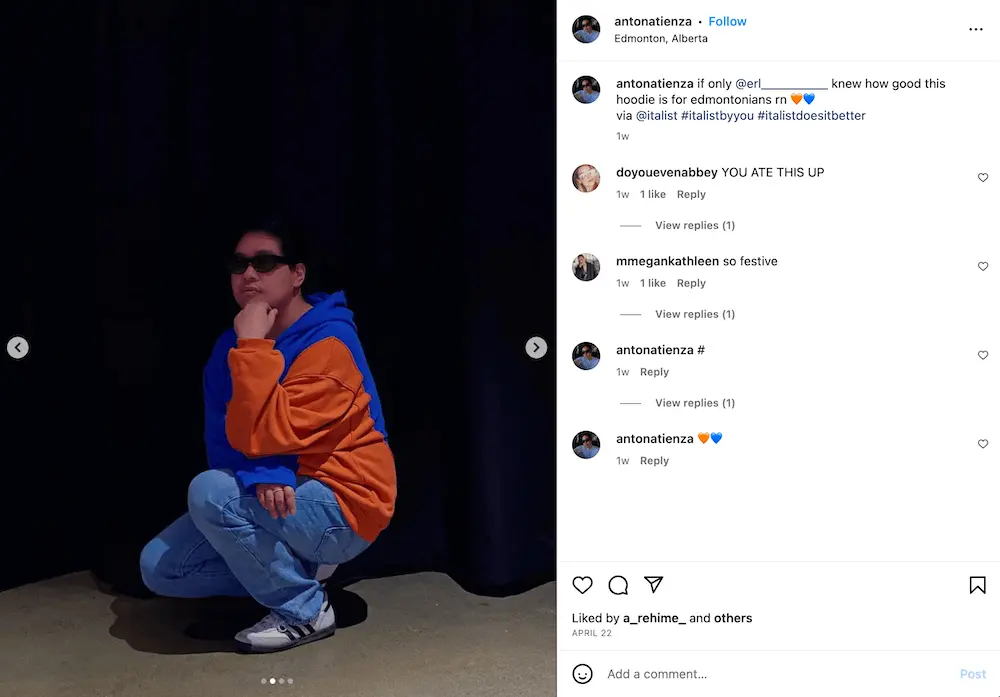
Image source: Italist’s tagged Instagram feed
This italist fan shows their appreciation by tagging italist in their caption and also using several branded hashtags (more on this later).
3. Reviews + testimonials
Reviews and testimonials refer to any kind of content that involves your customers sharing their opinions and experiences with your brand and products. And they’re particularly crucial for ecommerce brands that do most of their business virtually.
US shoppers expect a significant number of product reviews when shopping online, according to Statista—and the number increases the younger the demographic:
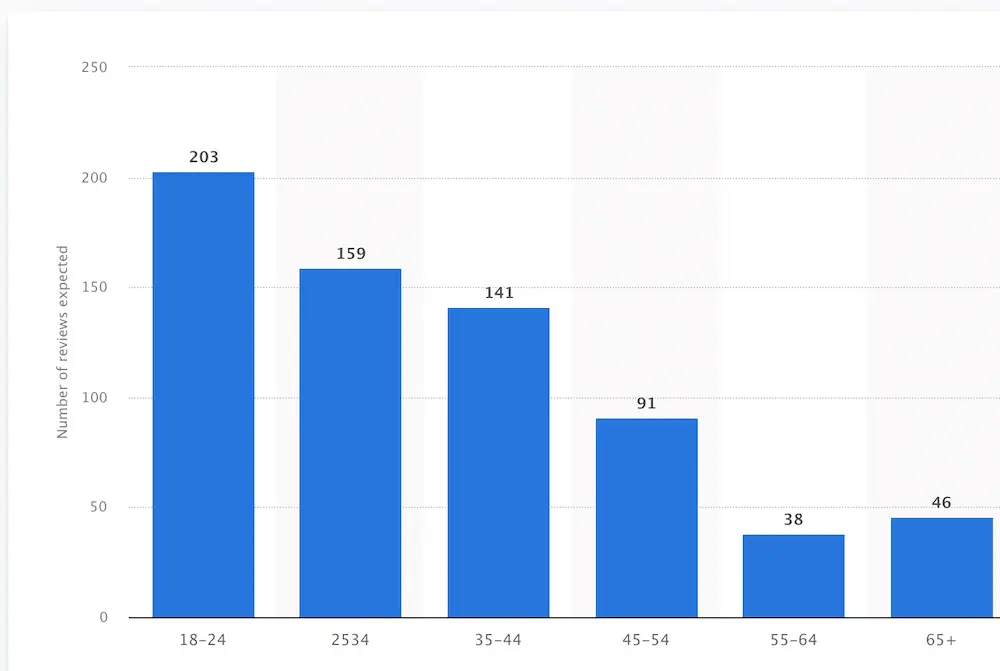
Image source: Statista
Check out these examples from the website homepage of nutrition supplement brand Promix. Notice how customer reviews don’t just have to pertain to your product—they can also speak to less tangible things, like the quality of your customer service:

Image source: Promix
4. Q&As
Q&As allow shoppers to ask questions about products or brands and receive answers from both other customers as well as the brands themselves.
This type of UGC not only gives shoppers access to answers they need from sources they trust, but also builds community by inspiring brand experts and past purchasers to share their knowledge.
Q&As are particularly useful for businesses that sell more complex products—like Gigaset, a company that has been designing and producing telephones in Germany since 1948.
“Q&A might be even more important [than reviews] because products are getting more complex,” Joerg Bruehl, senior vice president of marketing at Gigaset, told Bazaarvoice after implementing Q&A on product description pages.
“It’s very helpful to have a forum where people can ask questions and we’re able to answer them, but also other customers or potential customers are able to answer as well,” Bruehl explained. “This discussion also helps us get further insights on customer demands and product requirements from the customer side.”
How UGC benefits your business
According to the Bazaarvoice Shopper Experience Index, when shoppers engage with UGC, brands experience a 162% increase in revenue per shopper and a 144% increase in conversion rates.
Here are 5 key reasons behind those numbers:
UGC makes potential buyers more confident in their purchase decisions
Consumers love online shopping for one primary reason: It’s convenient. They can browse products from brands anywhere—on their laptops while they’re at home sitting on the couch, or on their phones while they’re out and about.
Basically, as long as there’s an internet or data connection, shopping is possible. But there’s a downside to such widespread accessibility: It sets up a digital partition between your customers and the products they’re browsing.
In a traditional brick-and-mortar store, you’re able to speak with a store representative, and you might be able to speak with other shoppers.
“In a traditional brick-and-mortar store, you’re able to speak with a store representative, you might be able to speak with other shoppers—you have that live interaction experience,” Lin explains.
In an online environment, by contrast, shoppers can’t see or touch the physical item. They can’t tell how it might look or function in 3D reality. And for a high-quality leather handbag brand like Latico Leathers, that’s a huge challenge.
“There are certain products which are hard to sell online because people need to touch, feel, and smell them,” Schreiber says—think verticals like fashion or health and beauty. “So for us and for many other brands like us, it’s about showing, not telling.”
For us and for many other brands like us, UGC is about showing, not telling.
How? According to the same Bazaarvoice survey, 53% of consumers say reviews help replicate the in-store experience online, and 75% would rather see customer photos and videos in online stores than professional imagery.
For new and returning customers alike, UGC like product demos and customer testimonials bridges the gap between browsing and buying by giving other members of your brand’s community valuable insights about your products—straight from the people who actually use them.
That might mean:
- The size of a product
- The quality of the materials
- What it looks like on different body types
- How it functions in different environments
UGC builds trust in your brand
As a marketer, you can make all sorts of promises or claims about what you’re trying to sell. But even if they’re valid, it’s hard to corroborate them or play the “take it from me” card when you stand to benefit financially if someone does actually take it from you.
In other words, marketing images and positioning can only get you so far. Most shoppers trust a customer who is reviewing a product over a marketer who’s trying to sell it.
A 2020 Gallup poll found that only 9% of Americans trust mass media “a great deal.” And according to the Bazaarvoice Shopper Experience Index, 32% of shoppers say “ads don’t work on me.”
Most shoppers trust a customer who is reviewing a product over a marketer who’s trying to sell it.
By contrast, 40% of global shoppers agree UGC makes them more likely to buy a product from an ad, according to the index—and 53% agree that UGC makes them more confident in a purchase decision. That’s higher than the 47% who say the same about professional photography.
The reason behind these numbers is straightforward enough: The opinions of real people are genuine and unbiased. Importantly, those people usually wouldn’t benefit from a sale. Their opinions are simply a reflection of their actual experience—which, for other consumers, is a whole lot more relatable than a pretty, polished ad campaign.
When you share UGC in your emails, on your product pages, or through social media marketing (more on this later), you’re not asking shoppers to take your word for it. That brings a level of authenticity—and transparency—to your brand that marketing or promotional messages simply can’t provide.
UGC turns prospects and customers into brand advocates
Because of that authenticity, UGC also has the potential to build a trustworthy online community of people who’ve graduated from customers into die-hard fans.
Abba explains how UGC serves “a dual purpose” for italist:
- “It fosters a sense of connection and community among our existing customers, whom we call ‘savvy shoppers’ in reference to their saving hundreds or thousands off retail for their favorite luxury fashion.”
- In turn, “their italist-centric UGC provides social proof to anyone new to italist who isn’t familiar with our value proposition. It’s an incredible way to crowd-source marketing content and show appreciation for our most loyal fans.”
Here, DTC expert Kristen LaFrance observes how athletic apparel brand Outdoor Voices used UGC to create a movement and build a community around it:
Outdoor Voices created a movement and then built a community around it.
— Kristen LaFrance (@kdlafrance) July 29, 2019
Their own instagram feed is at least 60% user-generated content. OV fan photos have even been placed in OV’s official ad campaigns.
This human connection is as critical as peanut butter for a PB&J. 🥪 pic.twitter.com/cKa4cJI8lZ
UGC saves you resources
On that note, the reason UGC is so cost-effective is because it essentially turns your customers into your content creators—either completely for free, or through low-cost incentives like discounts and giveaways.
“Creating high-quality content can be time-consuming and expensive,” points out Lindsey Arellano, director of email and SMS at CURIO. “By incorporating UGC, brands can tap into a vast source of content that is already available and can be repurposed for various marketing channels. This can help brands save time and money.”
By incorporating UGC, brands can tap into a vast source of content that is already available and can be repurposed for various marketing channels.
“Any quality photography or content that a business doesn’t have to pay for is a win,” agrees Hagar Vander, associate director of UX at Tomorrow Agency. “A brand that has an engaged user base can utilize a lot of really great UGC on and off the site to not only strengthen their community, but also link directly to products from anywhere.”
Even if you opt to pay a creator to make UGC for your brand, it’s going to cost less than hiring professional photographers, video editors, and full-time social media managers. Depending on the creator you’re working with, it’ll also probably cost less than influencer marketing.
Paid UGC creators vs. influencers
Confused about the difference between paying someone to create UGC and working with an influencer? With the rise of micro and nano influencers, the lines are getting blurrier—but here are a few general rules of thumb:
1. Paid UGC creators typically create content for your brand to use on your branded platforms.
2. Influencers typically create content to promote on their own platforms to their own followings.
3. The primary purpose of hiring UGC creators is to produce authentic content and share it with your existing audience.
4. The primary purpose of hiring an influencer is to earn authentic content and promote your brand to new customers who may be familiar with the influencer, but not your brand.
The content your customers generate, meanwhile, can help you create an effective content marketing program that builds brand awareness and improves your conversion rates.
UGC helps you figure out what is or isn’t working about your product
Positive UGC shouldn’t be your only focus. As Bazaarvoice puts it in their Shopper Experience Index, “UGC is your always-on focus group.”
Abba reads every single piece of feedback italist receives from customers. “I’m a big believer in engaging in two-way conversations with our customers through storytelling that is compelling and able to incorporate reactions, ideas, and feedback,” he says.
I’m a big believer in engaging in two-way conversations with our customers through storytelling that is compelling and able to incorporate reactions, ideas, and feedback.
In fact, when italist highlights positive reviews, they look for reviews that have a relatable narrative arc—something like, “I was skeptical at first, but I ended up having a great experience.”
Why? “This messaging performs much better than glowing reviews,” Abba explains. “We have plenty of those, but they’re not as helpful for potential new customers who need some reassurance.”
The numbers back this up: 60% of shoppers say negative reviews are as important as positive reviews in their decision to buy, according to the Bazaarvoice Shopper Experience Index.
Understanding the pain points of your customers gives you not only an opportunity to win back a customer’s trust, but also a chance to correct the course for future customers.
“We always think it’s so important to display the positive reviews, and it is, but not everyone might have the same experience, and not everyone might have a great experience,” Lin says. “Shoppers want to read about that, too.”
In addition to making your brand more credible, negative reviews, email unsubscribes, social unfollows, and other kinds of critical UGC can help make your marketing messages more effective and your audience targeting more efficient. Bazaarvoice brands, for example, use UGC to improve:
- Customer service: 72%
- Products: 66%
- Marketing tactics and messaging: 50%
“Understanding the pain points of your customers gives you not only an opportunity to win back a customer’s trust, but also a chance to correct the course for future customers,” says Drew Himel, CEO and founder of Fireside Digital.
In other words, negative reviews are an opportunity to solve a challenge for your customers. “Your internal product development team can gather a lot of insights about your products based on how customers are receiving and reviewing them,” Lin points out.
Your internal product development team can gather a lot of insights about your products based on how customers are receiving and reviewing them.
Take a look at how Charlotte Stone Shoes responds when one of their customers claims the brand sold them a shoe that doesn’t match their online sizing guide:

Image source: Charlotte Stone Shoes
By turning this customer feedback into an opportunity to ensure new shoes align with size guides in the future, Charlotte Stone Shoes shows how a negative review can be helpful in rethinking aspects of your product or service you might not have considered.
3 reliable places to find UGC
OK—the benefits of collecting UGC are clear. But how do you actually mine it from your customers?
To source high-quality UGC, italist encourages interaction with the brand’s main social media channels—Instagram, TikTok, YouTube, Pinterest, Facebook, and Twitter.
“We also frequently incentivize our shoppers to participate in contests, become brand ambassadors, and share their experiences with italist however they feel most comfortable,” Abba explains.
Here are 3 reliable ways to collect UGC:
1. In a post-purchase flow
The easiest way to get something you want? Ask. Bazaarvoice reports that using review request emails increases review UGC quantity by 10x.
A post-purchase email automation is an email that goes out a few weeks or a month after a customer makes a purchase. The timeframe varies depending on your product and its proven time to value—remember, you have to give someone time to actually try your product and form an opinion on it before asking them to brag about it.

Image source: Klaviyo
It never hurts to include a little treat for your customers as a way to entice them to take your desired action. And “treat” doesn’t have to mean “discount.”
Watch how Credo Beauty incentivizes customers to leave a review without relying on a coupon code:
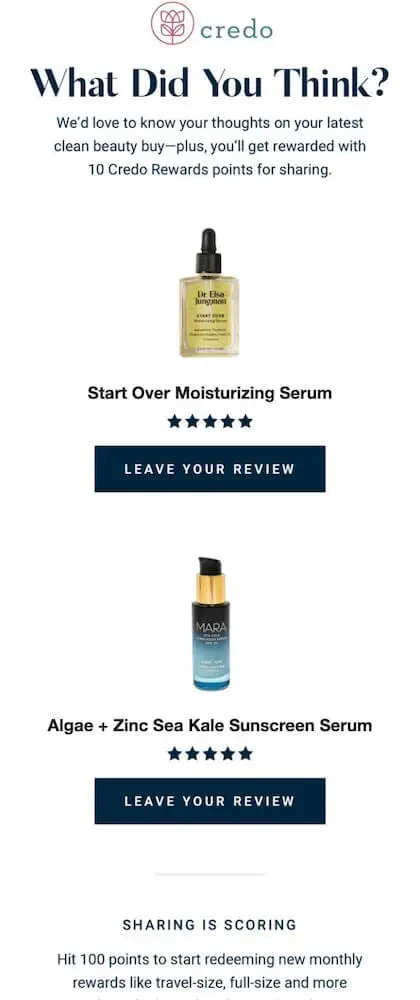
Image source: Credo Beauty
Alex McPeak, content marketing manager at Klaviyo, points to home decor brand Sunday Citizen for an example of how one-upping your own incentive program can encourage customers to include visual proof with their review:
Smart to incentivize customers to leave a review with a % off their next purchase. Even smarter? Increasing the discount for people that include a pic of their item!! Signed someone whose decision making process is like 80% based off reviews pic.twitter.com/MuZROQeZpB
— Alex McPeak (@almcpeak) December 19, 2020
This is a crucial step that many DTC brands are ignoring, Schreiber believes. “The image or video part is what makes a review believable, right? You can’t fake that the way you can fake copy,” he points out. “Incentivizing your customers to upload a review with an image or a video is super important.”
2. Organically on your website
In addition to explicitly asking for UGC, you can also take a slightly more indirect route to the same end goal: Allow your customers to leave reviews on your product pages at any time.
Companies like Bazaarvoice offer technology that makes it easy not only for brands to implement a reviews program on their websites, but also for customers to leave reviews that include images and videos of the products they use and love.
Here, you can see how optical brand Raen makes leaving a review as easy as clicking a button on their website. Pay close attention to the fine print, too:
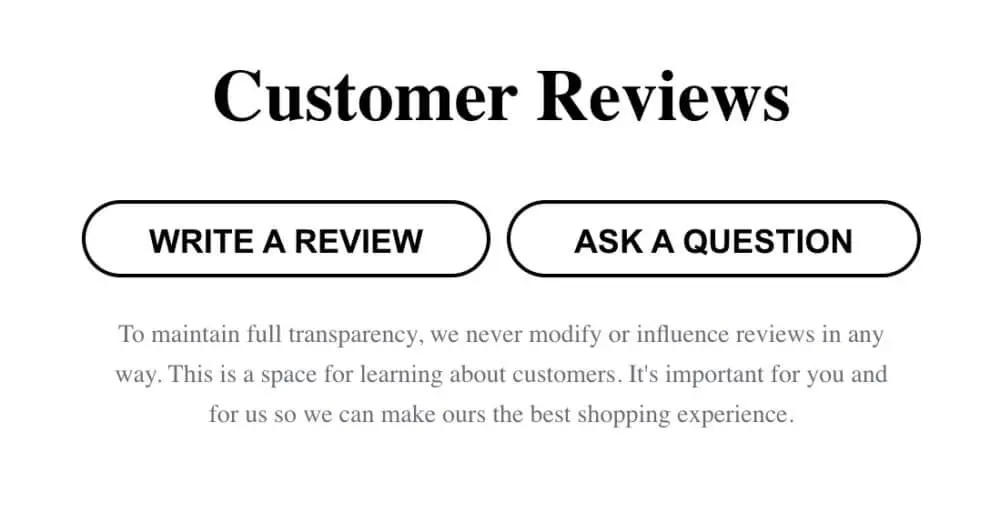
Image source: Raen
Raen wants customers and site visitors to feel like they have a place to openly share their opinions and experiences, so consumers can decide for themselves if their product is right for them.
3. Through branded hashtags and social communities
You can also use a branded hashtag to invite your customers to share their own pictures, stories, and reels that include your brand’s products.
Promote your hashtag on a webpage, in the footer of an email, in an SMS campaign, or on your social channels so your customers know exactly what to tag when they post their images.
italist, for example, uses the hashtag #italistbyyou to collect UGC from customers on Instagram:

Image source: the #italistbyyou Instagram feed
But hashtags aren’t the only way to gather UGC on social media. Latico Leathers, for example, recently launched a free Facebook group for insiders, where users guide the content, answer each other’s questions, and share their experiences with the brand.
For Latico, a Facebook group makes more sense than a hashtag because their customer demographic skews toward older women.
“It’s the best way for us to not only collect UGC and gain insight into our product, what people want, and what they’re not happy about, but also build a genuine VIP community for our brand,” Schreiber explains.
How to incorporate UGC into your omnichannel marketing strategy
Once you take stock of all the UGC you’ve accumulated, the question becomes: Now what?
Abba puts the answer simply: “We use UGC across all our digital touchpoints.”
We use UGC across all our digital touchpoints.
Here are a few ways to use UGC to educate your target audience about your products and services—and nurture them until they’re ready to make a purchase.
Share UGC on your organic social accounts
Your social followers are more interested in seeing your products on real people, from diverse backgrounds, than models.
According to TINT’s State of Social and User-Generated Content 2023 report, 64% of consumers are more likely to post about a brand that re-shares content by its audience. And Bazaarvoice reports that 64% of shoppers want brands to share visual and social UGC on social media.
“We regularly re-post excellent UGC in our social media channels as a way to reinforce the sense of community among our shoppers, highlight new faces, and share in the beauty of luxury goods with the savings of being direct from Italy,” Abba says.
Here’s an example from undergarment brand Parade: In a recent carousel series on Instagram, they posted photos from a diverse range of customers wearing their new sleepwear line—ensuring that anyone can imagine themselves in the brand’s products.
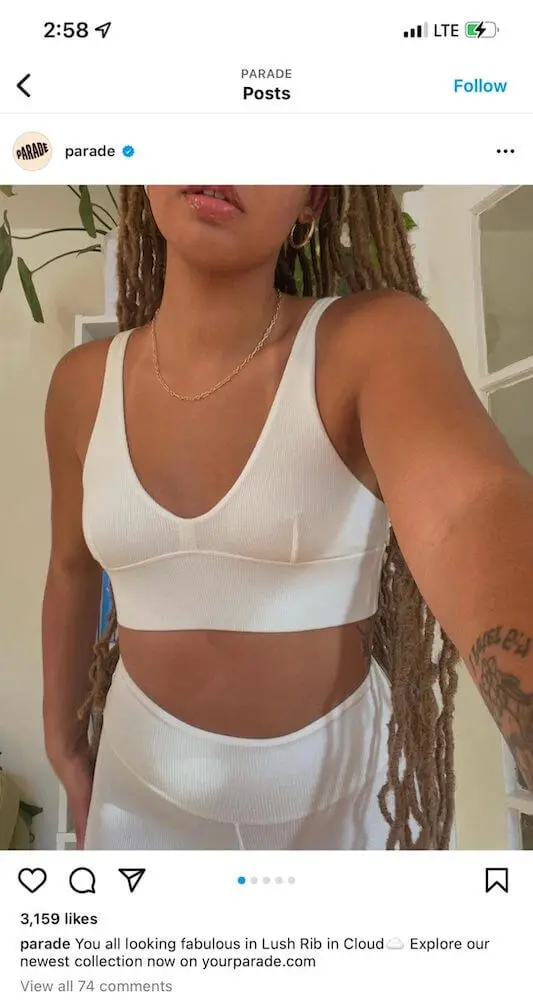
Image source: Parade’s Instagram
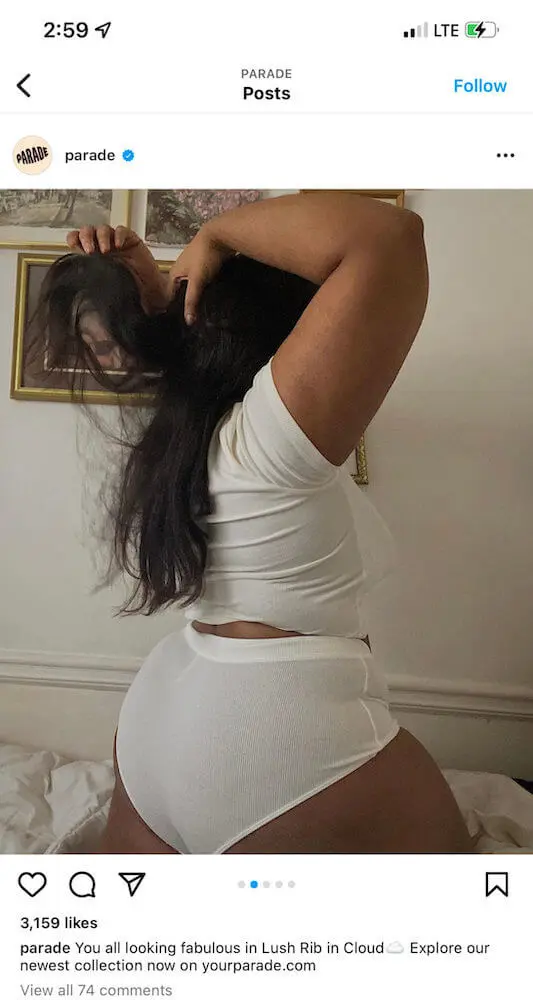
Image source: Parade’s Instagram
Outdoor Voices also makes social posts that consist solely of UGC—images submitted from their community of loyal customers, which showcase their products in active environments. Take a look:

Image source: Outdoor Voices’ Instagram

Image source: Outdoor Voices’ Instagram
Incorporate UGC into your paid advertising efforts
UGC is also incredibly effective in paid media. Just ask DTC bedding and bath brand Parachute, which historically relied on professional, brand-created editorial content and sleek, eye-catching ads.
Those polished creatives worked well for attracting new customers. But when it came to bringing familiar customers back to their site, Parachute wasn’t seeing the kind of performance they wanted.
So they changed tactics. With help from Bazaarvoice, Parachute incorporated lifestyle imagery from customers who tagged the brand in their organic posts on social media, and created retargeting ads that showed consumers styling and using Parachute products in everyday life.
The results speak for themselves: 35% higher click-through rates and a 60% lower cost per click.
“We’ve seen that our customers have a higher propensity for clicking on and engaging with rich UGC imagery than traditional product-centric imagery,” Luke Droulez, CMO at Parachute, told Bazaarvoice.
If you’re going this route, just be mindful that advertising with UGC is still advertising—which means it’s subject to specific rules and regulations.
Add UGC to your website and product pages
Your website is one of the places people spend the most time learning about your products or services—and if you’re an ecommerce brand, it’s also where they’re most likely to buy them.
This one goes beyond the customer experience and customer education: The Bazaarvoice Shopper Experience Index reports a 29% increase in web conversions when a brand’s website contains UGC. Bazaarvoice also reports that:
- Onsite photo galleries of UGC drive a 54% increase in conversions and an 80% increase in revenue per visitor.
- Shoppers are more likely to buy a product if the product page features:
- Written reviews: 81%
- Customer photos: 66%
- Customer videos: 62%
Why? “If you think about a product description page, that page is fairly static,” Lin points out. “The description doesn’t change, the title doesn’t change, and the image typically doesn’t change. The part that’s dynamic is the UGC portion. That content is constantly being refreshed.”
“If the content on your product page isn’t fresh, it’s considered old,” Lin adds—and worse than the fact that 47% of shoppers consider reviews no longer relevant when they’re only 3 months old, according to Bazaarvoice, is what this means for your site’s position in the SERPs.
If the content on your product page isn’t fresh, it’s considered old.
“Google really does not like old, stale content,” Lin explains. “The SEO impact of updating your product pages with fresh UGC can be huge.”
There are a variety of creative ways to weave UGC throughout your website. Watch how italist incorporates the UGC they collect through their #italistbyyou hashtag on this landing page, “where you can go back many months and years to see all the people who love italist,” Abba says:

Image source: italist
Latico Leathers, meanwhile, incorporates UGC throughout their website, beginning with above the fold on the homepage:

Image source: Latico Leathers
Similarly, every product page, Schreiber says, includes at least one UGC photo or video:

Image source: Latico Leathers
“When people are on your product pages, mainly what they’re trying to do is picture the product on themselves or picture themselves using the product,” Schreiber explains. “If they see 20 people posting a picture of the product with a 4- or 5-star review, that’s relatable and it’s trustworthy. It gives people the extra push they need to buy.”
Take a look at how Rare Beauty exemplifies this advice on their product pages, which contain an animated reel of customers from their brand’s community so potential buyers can see what a lipstick or blush looks like on a variety of complexions:

Image source: Rare Beauty
Weave UGC into your email and text message marketing
Your owned marketing channels, including email and SMS, are another natural vehicle for serving up UGC to your audience.
Think of these channels as a low-cost nurture stream. For subscribers who aren’t quite ready to make a purchase, email and SMS can further educate them about a product and brand they’re interested in.
Consider this example from sparkling water brand Aura Bora. Their product launch email uses real customer reviews to entice subscribers to give a new drink flavor a try:

Image source: Aura Bora
These product descriptions may be subtly promotional. But from the realness of the taste to the drink’s ability to evoke memories of paradise, they’re also readable, authentic shout-outs from actual people who genuinely love the flavor. Who wouldn’t want what they’re having?
Here are a few particularly effective email and SMS flows for sharing various types of UGC:
- Welcome flows: Get new subscribers excited about your brand by not only telling your story, but showcasing UGC that tells it for you.
- Browse abandonment flows: Use product-specific UGC to encourage subscribers to click through to your site, or cross-sell them on similar items.
- Abandoned cart flows: Use product-specific UGC to help convince consumers that the item in their cart is worth another look.
- Post-purchase flows: Get new customers excited about their purchase by offering customer content that validates how great the product will be when it arrives.
By integrating a UGC platform like Bazaarvoice with a marketing automation platform like Klaviyo, you can even send these types of emails to specific audience segments based on the kind of UGC your customers are posting.
Let’s say a bunch of customers leave rave reviews for your hero product. You might create a segment of those customers, then send them up- and cross-sell email marketing messages with related product recommendations, Lin suggests.
By contrast, customers who leave negative reviews “need to be communicated with in a different way,” Lin points out. You might create a segment of those customers, then send a post-purchase email with a discount offer to try to win back their business.
Or what about customers who end up returning their product? “You probably shouldn’t ask them for a review,” Lin points out. Smart segmentation helps you cater your owned marketing to the people who are most likely to appreciate it.
5 best practices for collecting and using UGC in your marketing
When working with UGC, italist sticks to “a few general rules,” Abba says: “No politics, lots of diversity, and ensuring a good mix of geographies, personal styles, etc.”
As you’re building out your own UGC strategy, here are 5 best practices to keep in mind:
1. Ask permission and credit the creator
Abba advises being “respectful of all UGC that comes in,” and “gracious about the process of curating what you re-post or re-use.” That means securing permission before you share, and giving credit where it’s due.
2. Stay on trend
Especially if you’re incorporating UGC into your social media strategy, remember: “You have to hone in on what people are looking to do on the platform,” Schreiber says.
On TikTok, for example, that means “thinking about trendiness—what songs are trending, what challenges are trending, and then piggy-backing off current events. That’s going to give you a boost in the algorithm,” Schreiber explains.
You have to hone in on what people are looking to do on the platform.
“You have to be quick on your feet,” Schreiber adds. “That’s how you’re going to get a ton of views. If you can try to relate that to your product in a humorous or witty way, that’s a plus.”
Brand Caffeine, which Schreiber co-founded with his sister, professional content creator Liv Schreiber, has brainstormed and produced plenty of viral UGC for the 25 DTC clients they manage monthly—and Schreiber’s key piece of advice based on those experiences is to figure out a way to stand out.
“You can start a brand in 5 hours,” he says. “The hard part is differentiating yourself and making yourself unique.”
At the end of the day, Schreiber says, “a lot of people forget these are social networks. These people aren’t shopping on your website. They aren’t necessarily in a ‘buy’ mindset. They want to be entertained in an authentic way.”
These are social networks. These people aren’t shopping on your website. They aren’t necessarily in a ‘buy’ mindset. They want to be entertained in an authentic way.
One final note on video content: “You can’t waste a single millisecond,” Schreiber says. “The hook needs to be right away, and it needs to be thumb-stopping. And a lot of people are consuming content without volume, so make sure you’re using captions.”
3. Be authentic
The whole point of UGC is that it doesn’t feel like a sales pitch. If your UGC feels like a commercial, consumers will see right through it. “The risk of UGC is that it appears too scripted—too staged,” Abba says. “The best UGC is authentic, organic, and honest.”
The best UGC is authentic, organic, and honest.
On a similar note: In order to prevent inappropriate, fraudulent, or offensive content from being associated with your brand, it’s important to moderate your UGC.
A UGC platform like Bazaarvoice handles this for you, with multiple layers of protection, Lin points out—an authenticity and moderation process that he believes differentiates Bazaarvoice from other UGC platforms, “even Amazon.”
“After it goes through the computer-automated systems, humans are actually looking at the content as well to ensure it’s meeting our standards,” says Lin, who notes that Bazaarvoice has “invested heavily in these systems” and has over 15 years of experience in combating bad actors.
“We have paramount responsibility to the brands and retailers that have entrusted us with the content that will be displayed on their sites to be shared with customers,” Lin explains. “We really pride ourselves on curating content in a way where shoppers can trust that what they’re reading is authentic and real.”
At the end of the day, the UGC still has to look nice and be in line with our mission in order for it to make sense to re-use.
The italist team tries to keep UGC “light, friendly, and focused on the topic: a huge selection of luxury brands below retail pricing,” Abba says. “At the end of the day, the UGC still has to look nice and be in line with our mission in order for it to make sense to re-use.”
4. Be transparent
On that note: It’s completely acceptable to reward your customers for sharing UGC about your brand. But something Lin says many brands overlook when it comes to using UGC is clearly articulating what exactly went into sourcing it.
Bazaarvoice handles this through a badging process that separates organic UGC from UGC a brand obtains by offering some kind of incentive, such as a discount, gift card, or free gift.
“That creates transparency in the marketplace about the reviews we’re displaying for brands,” Lin explains. “I believe that’s really important. I don’t think it should be hidden that there was some incentive behind that review.”
5. Understand your strategy—and update it regularly
Like all forms of marketing, UGC isn’t right for every situation. You have to be smart about when you’re applying it.
At italist, for example, “UGC lends itself well to brand awareness-level messaging, but is less helpful when communicating about specific brands, items, new collections, or sale announcements,” Abba explains.
It’s important to have a solid, ongoing strategy of collecting that UGC and then using it across all your marketing channels continuously.
And remember: Incorporating UGC into your broader marketing plan “is not a one and done,” says Ashlei Valles, partner marketing manager at Bazaarvoice.
“Once you’ve launched your product and you get your 50 reviews, you’re not just set,” Valles says. “It’s important to have a solid, ongoing strategy of collecting that UGC and then using it across all your marketing channels continuously.”
Let your current customers help you acquire new ones
UGC isn’t just the best way to show potential customers how your product works and how your brand fits into their lives. It also allows you to lean on your best customers—the ones who already know and love your brand—to bring new people into the fold.
“The attention span of consumers and the affection that they once had with certain brands has declined massively,” Abba points out. “If brands do not continuously focus on better interactions with their consumers and ensure meaningful engagement, customers will switch and move on to something else.”
Building a strong team of promoters from the get-go means securing and ensuring the power of word of mouth—one of the strongest tools of loyalty.
Loyalty, Abba believes, “should be the goal from the very beginning. Building a strong team of promoters from the get-go means securing and ensuring the power of word of mouth—one of the strongest tools of loyalty.”
And that loyalty speaks louder than any marketing message you can concoct in a team huddle.
Your customers are your brand’s secret sauce. Let their voices and their experiences help you reach your goals.
User-generated content (UGC) FAQs
Why is content moderation important for UGC?
UGC moderation is important for preventing inappropriate, fraudulent, or offensive content from being associated with your brand. In today’s world of fake reviews, robust authenticity standards can protect your balance sheet from reputational backlash that would impact the value of your brand or global legislative fines that would impact your revenue.
Which marketing channels can use UGC as a growth tactic?
Pretty much all of them. Use UGC on your social media platforms, across your website, in paid ads, in SEO programs, in email and SMS marketing, and even in store with QR codes or handheld devices. Across all marketing channels, UGC can instill shoppers with the confidence they need to move forward with a purchase decision.
How does UGC build trust in a brand?
Compared to the claims of ecommerce advertisers and marketers, who stand to benefit financially from making a sale, consumers perceive the opinions of real people as more genuine and unbiased. They’re simply a reflection of someone else’s experience—which tends to be a whole lot more relatable, and reliable, than a pretty, polished ad campaign.

Related content

Discover the best marketing automation platform for 2026 and learn how to choose based on data, integrations, scalability, and the features that drive real customer value.
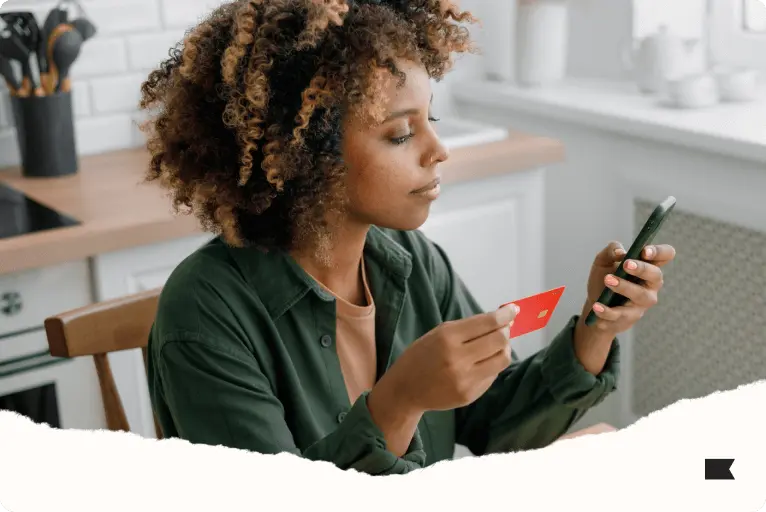
Discover 4 proven ways to reduce cart abandonment and recover lost sales. Learn how to build trust, streamline check-out, and personalize abandoned cart flows to convert more shoppers.
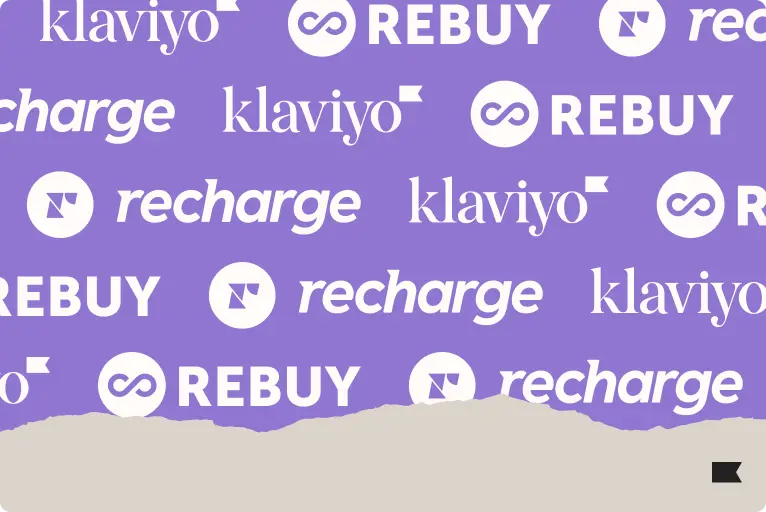
Looking for the best Shopify apps for marketing and customer service? Klaviyo, Rebuy, and Recharge together create a high-performing tech stack that revenue and customer retention.